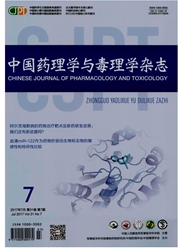

 中文摘要:
中文摘要:
目的建立蜂毒诱发大鼠结肠炎疼痛实验模型,用于镇痛药的评价及相关机理研究。方法利用蜂毒结肠粘膜下注射诱发大鼠结肠炎疼痛,动态定量评价大鼠的疼痛行为学反应,并进行组织学检查,同时与甲醛相比较。结果每只大鼠结肠粘膜下注射蜂毒0.075,0.15和0.3mg可剂量依赖性地诱发犬鼠持续性内脏痛,与5%甲醛(0.1mL)相比,蜂毒0.3mg致痛反应效应相当,第二相炎症反应明显,且持续期长;局部组织损伤轻。阿片类镇痛药吗啡、解热镇痛药阿司匹林和新型环氧合酶2抑制剂NS-398均能抑制蜂毒诱发的大鼠结肠炎疼痛。结论蜂毒诱发大鼠结肠炎疼痛模型反应指标客观、实验重复性好,是一种较理想的内脏疼痛实验模型,可用于镇痛药的评价及机理研究。
 英文摘要:
英文摘要:
AIM To establish the model of bee venom-induced colitis pain in rats for drug evaluation and related mechanism research. METHODS The colitis pain in rats was induced by colonic submucosal injection of bee venom, with the formaldehyde as control, the nociceptive response was dynamically quantified, and histological analysis was also proceeded. RESULTS Colonic submucosal injection with 0. 075, 0.15, and 0.3 mg bee venom dose-dependently induced a continuous visceral pain in rats. Compared with 5% formaldehyde (0.1 mL), the bee venom 0. 3 mg had same strong response effect, but more obvious and durable response of state Ⅱ inflammation, and little local damage. The bee venom induced colitis pain was suppressed by morphine, aspirin and NS-398, an inhibitor of cyclooxygenase 2. CONCLUSION The model of bee venom-induced colitis pain in rats has been established. The model is suitable for visceral pain experiment and can be applied to drug evaluation and related mechanism research.
 同期刊论文项目
同期刊论文项目
 同项目期刊论文
同项目期刊论文
 期刊信息
期刊信息
